Progress report for LNE21-420
Project Information
Problem and Justification: Soil health (SH) is the outgrowth of recognition that soil is a dynamic and complex environment harboring multiple functions. For the small-scale farmer, adopting practices known to improve soil health is hampered by the expense of laboratory soil tests giving quantitative measures of SH that may be related to productivity. The suite of approved/proposed SH measures to be provided through routine laboratory tests has not been examined for their value to, and potential adoption by, small farmers.
Solution and Approach: We propose an iterative and participative three-stage approach to increased SH adoption that relies on field and laboratory research, economic assessment, and education. Team members will identify 30 to 50 participating farmers representing two key Appalachian region land uses located in West Virginia; high tunnel production (USDA defined specialty crop) and managed grasslands (hay/pastures). Stage 1: Farmers will be identified by the WVU Soil Testing Lab and WVU extension agents. Based on soil samples collected from these farms, and considering SH variables suited to laboratory determination, we will work field-to-lab to identify the most responsive laboratory biological (e.g. respiration, enzyme), chemical (e.g. nutrients) and physical (e.g. aggregation) methods to distinguish categorical SH levels (e.g. low, medium, good) related to land-use productivity. Soil health test results will be correlated to productivity of chosen land uses so as to generate preliminary management recommendations. Correlation will be based on yield measurements for the crops common to high tunnels and grasslands and/or to indigenous/local productivity knowledge. A short-term evaluation of perceived benefits from SH testing will be made. Surveys will evaluate interest and potential adoption by additional farmers. Stage 2: Cost optimization for the best SH tests previously identified will be used to select the best combination of analyses (price/efficiency/farmer approval) for Appalachian farmers. Our goal is to create a suite of SH tests with a cost of less than $35 for WV landowners (WV partially subsidizes routine analyses) and less than $45 for other Appalachian states. Stage 3: For the methods selected in Stage 2, we will design field soil sampling and sample submission methods, a sampling Do-It-Yourself ‘kit’ for the Appalachian region (as defined by the Appalachian Regional Commission). With the participation and feedback of early farmer participants, and support of extension agents from several WV counties, educational videos will be developed to illustrate to prospective users the how, when, and where of effective SH sampling, lab report interpretation, and the economic and environmental benefits to implementation of recommended practices. Early adopters can demonstrate the effectiveness of improved SH management and stimulate the broader adoption of SH testing and SH management.
At project’s end we expect that lower soil health test costs will motivate 100 farmers/year (in WV and other neighboring Appalachian States) to adopt the New WV Appalachian Soil Health Test for 25/year high tunnels and 1000 grassland acres, repeating the test every two to three years and implementing recommended management/conservation practices (organic materials amendment, rotational grazing) and causing a 20% improvement in later measures of one or more soil health indicators.
Soil health is the outgrowth of recognition that soil is a dynamic and complex environment harboring multiple functions. For the small-scale farmer, adopting practices known to improve soil health is hampered by the expense of laboratory soil tests giving quantitative measures of soil health that may be related to productivity. The suite of approved/proposed soil health measures to be provided through routine laboratory tests has not been examined for their value to, and potential adoption by, small farmers. We propose an iterative and participative three-stage approach to increased soil health adoption that relies on field and laboratory research, economic assessment, and education. Team members will identify 25 to 50 participating farmers representing two key Appalachian region land uses located in West Virginia; high tunnel production (USDA defined specialty crop) and managed grasslands (hay/pastures). Stage 1: Farmers will be identified by the WVU Soil Testing Lab and WVU extension agents. Based on soil samples collected from these farms, and considering soil health variables suited to laboratory determination, we will work field-to-lab to identify the most responsive laboratory biological (respiration, enzyme), chemical (nutrients) and physical (aggregation) methods to distinguish categorical soil health levels (poor, good, excellent) related to land-use productivity. Soil health test results will be correlated to productivity of chosen land uses so as to generate preliminary management recommendations. Correlation will be based on yield measurements for the crops common to high tunnels and grasslands and/or to indigenous productivity knowledge. A short-term evaluation of perceived benefits from soil health testing will be made. Surveys will evaluate interest and potential adoption by additional farmers. Stage 2: Cost optimization for the best soil health tests previously identified will be used to select the best combination of analyses (price/efficiency/farmer approval) for Appalachian farmers. Our goal is to create a suite of soil health tests with a cost of less than $35 for WV landowners (WV partially subsidizes routine analyses) and less than $45 for other Appalachian states. Stage 3: For the methods selected in Stage 2, we will design field soil sampling and sample submission methods, a sampling Do-It-Yourself ‘kit’ for the Appalachian region. With the participation and feedback of early farmer participants, and support of extension agents from several WV counties, educational videos will be developed to illustrate to prospective users the how, when, and where of effective soil health sampling, lab report interpretation, and the economic and environmental benefits to implementation of recommended practices. Early adopters can demonstrate the effectiveness of improved soil health management and stimulate the broader adoption of soil health testing and soil health management.
Cooperators
- (Educator and Researcher)
- (Educator and Researcher)
- (Educator and Researcher)
- (Educator)
Research
Making soil health testing affordable to small farmers in WV and the Appalachian Region will increase adoption of conservation practices that promote sustainable agricultural production. Can a cost-effective suite of laboratory soil health measures for the region’s soils/plant production systems, measures that will be diagnostic of current and changing soil health, be found and correlated to productivity in order to accomplish this goal? Research based educational materials, produced in an iterative fashion with the collaboration of farmers and extension agents, will increase the adoption of the new laboratory SH test suite.
Year 2022:
The hypothesis we proposed for the project continues to drive our proposed research and education goals. We are processing data to test the hypothesis. Preliminary analysis has been completed in a set of 150 samples sampled on 26 farms.
Year 2023:
The hypothesis we formulated for the project remains a guiding force for our research and educational objectives. We are actively engaged in processing data from over 400 soil samples to rigorously test this hypothesis. Initial analyses of specific properties have already been concluded for a subset of 250 samples collected from 26 farms. Additionally, presentations have been delivered to extension agents in both the State of West Virginia and Massachusetts.
The project takes place in the Appalachian Region, in West Virginia (Figure 1, Supplemental File), with participation of research and extension faculty from the University of Kentucky. Thirty to fifty producers (first adopters) from ten WV counties will be identified and invited to participate. Producer farms selected for sampling should contain ‘benchmark’ soils (Tilsit, Gilpin, and Berks soil series) of the Appalachian Plateau Physiographic Region (Figure 2, Supplemental File).
The research is divided into three components: Field/Lab research, Field correlation research, and Economic research.
Field/Lab Research:
Objective 1): Select laboratory measurements that are SH ‘indicators’. From these, develop a production system specific Soil Health Test (laboratory SH measurements suite).
Objective 2): Generate sampling protocols for selected SH indicators. Develop ‘sample/sampling kit’.
a) Treatments:
Treatments are a factorial combination of four factors. We selected three (3) common production systems: managed grassland (for hay and for grazing, separate systems) and high-tunnels. Each field/high-tunnel is divided into productivity zones deemed low, medium and high using indigenous farmer knowledge or measured plant productivity. Each field zone will be sampled 0-6 inches deep, at two times (spring and fall), and for two shipping methods (conventional and WVU proposed). Combinations of production systems, field zones, sampling season, and submission method will create 36 different treatments (3*3*2*2). The rationale for selecting these factors are: 1) the representativity/importance of chosen production systems for Appalachia; 2) the need to correlate SH with productivity; 3) that SH properties are dynamic, changing with time and no recommendation for SH property sampling time exists; 4) that SH properties are management-related; and 5) that SH properties are known to be sample-handling sensitive such that an alternative SH sample shipping method needs evaluation.
b) Field and Lab Analysis Methods:
The variables to be analyzed in the first set of samples are presented in Table 1, and the analysis methods are in the supplemental file (Methods and references).
Table 1. Soil health indicators to be measured and evaluated.
|
Physical |
|
Texture |
|
Structure/Aggregation: Modified WVU wet aggregation |
|
Available Water/Water Retention
|
|
Chemical |
|
pH |
|
Electrical Conductivity |
|
Organic Matter |
|
Available Elements (Phosphorus, Potassium, Calcium, Magnesium)
|
|
Biological |
|
POxC |
|
Dehydrogenase Activity |
|
Mineralizable Nitrogen |
|
Biomass/Plant Speciation |
|
Soil Respiration |
We will determine factor significance/impact on measured variables using statistics. With this information we will know which variables are more stable, and will select the more sensitive variables by production system, site productivity, sampling season, and submission method. We will recommend the most robust laboratory SH measures in the “New WVU Soil Health Test”.
c. Farmer Input:
Since 2019 informal phone surveys have been conducted by the WVU Soil Testing Laboratory. Farmers ask about postage and SH testing costs; soil sampling instructions; and about resulting recommendations. During the farm/field identification and sampling process, we will rely on participating farmers’ indigenous knowledge as representative samples from high-tunnel/field locations regarded as low, medium or good in productivity are taken and returned to the WVU Soil Test Laboratory. Producers will also be asked to collect/provide relevant yield and/or other productivity data. Additionally, farmer feedback will be used when developing the new WVU Soil Health soil test report.
Field Correlation Research:
Objective 1): Use correlation analysis to select among laboratory SH measurements (Table 1) for those better related to high-tunnel and grassland productivity. This may include correlation with qualitative, indigenous, measures of productivity.
Objective 2): Develop preliminary recommendations, using experimental and literature data, to link laboratory SH measures with recommended practices. Practices may include cover cropping, tillage reduction/cessation, organic matter addition, crop rotation components, and grassland management options.
a) Procedures:
Field/high-tunnel sampling sites are assigned, via indigenous knowledge or field measurement, as either low, medium, or high productivity. Indigenous knowledge comes from the cooperating farmer/grower. Field measurements of productivity will include biomass/botanical composition to determine dry matter production of desirable species in grassland systems and horticultural crop yields under high-tunnel production. In the absence of field production measurements, qualitative indigenous assignments will become the response variate correlated with the laboratory SH measurements – this may be especially important in plant-species-diverse high tunnel systems. The rationale for this approach to determining productivity level is that farmer/grower’s experience is sufficient to make the assignment. The assumption that these sampled areas will have correspondingly low, medium and high SH is hypothesized and subject to the outcome of the correlation analysis.
b) Correlation Analysis Methods:
Correlation analysis is determining the relationship, if any, between y, the response variable (productivity measured or assigned), and the x variable (laboratory SH measurement). All laboratory SH tests (Table 1) would be evaluated to determine those SH measures most responsive/sensitive, and best able to predict productivity. Combinations of laboratory SH tests would also be examined. The data would be divided according to production system and, perhaps, sampling season. Chosen laboratory SH measures will be subject to the economic analysis described below.
c) Data Collected:
Data collected for this research component/analysis are the productivity information/data as related to each sample location, and the SH measurements listed in Table 1.
Economic Research
Objective 1) Use data from the proposed laboratory SH test analyses (Table 1) to identify a cost-efficient suite of SH measures for small Appalachian farms.
Objective 2) Estimate farmer willingness to pay (WTP) for SH testing/adoption.
a) Study Population(s): 30-50 small Appalachian farms with grassland and high-tunnel production.
b) Methods:
According to producer theory, farmers face a profit maximization problem: they need to maximize revenues and/or reduce costs to attain higher profits. Our economic objectives contribute to farmer profit maximization problems in two ways: 1) devising a cost-efficient SH test and; 2) determining farmer WTP for SH testing. WTP can be determined using farmer information on how much they would spend on a soil test (i.e. stated preference methods).
c) Data Collection and Analysis:
A nonparametric approach is used to determine the most cost-efficient SH test suite (i.e. group of tests with highest explanatory power at lowest possible cost). This approach minimizes the cost of an SH test of a explanatory power, given input cost (i.e. input price times quantity). Inputs considered include labor, laboratory facilities/equipment, turn-around time, and chemicals (Model 1 Supplemental File). The approach ranks SH test combinations from most to least efficient. Results will cause identification of soil test combinations minimizing testing costs while ensuring representativity. This determines the most cost-efficient SH test that can be supplied. Next we determine farmer WTP (i.e. demand). WTP for SH testing is estimated using a contingent valuation model (CVM) and data collected from farmer surveys (Model 2 Supplemental File). Information on WTP estimated from surveys at the project start will aid in choosing a cost-efficient SH test. At project’s end we overcome a criticism of CVM, that respondents may overstate their WTP due to biases, by investigating whether farmers will buy the SH test at the price we determined.
d) Farmer Input:
Farmers will participate in: a) responding to surveys at project beginning and end; b) allowing soil sampling on their farms; and c) providing feedback on test costs and recommended practices. Farmer input may help identify subsidy amounts needed to motivate small farm adoption of SH testing.
Year 2022:
No changes were made to any project portion, including the materials and methods (see results for more info).
Year 2023:
No modifications were implemented to any aspect of the project, including the materials and methods (refer to the results section for further details). As the project progresses, the results obtained and analyzed provide substantial support for the ongoing advancement of the project. The information being generated proves to be highly valuable for the assessment of Soil Health in both high tunnels and grasslands within the Appalachian region.
Year 2022:
The project has generated farmer field results.
We were able to visit and sample 26/30 farms. Figure 1 shows some examples of sites visited and the sampling process.
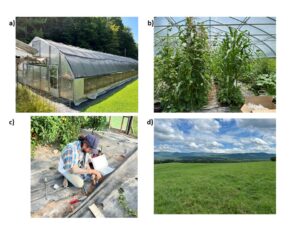
Research results and discussion:
The hypothesis we proposed for the project continues to drive our proposed research and education goals. We are processing data to test the hypothesis. Preliminary analysis has been completed on a set of 150 samples taken on 26 farms.
Materials and Methods:
The selected students (two graduate and two undergraduate) recruited in 2021 were trained to perform field sampling and laboratory processing and analysis of the soil samples. We followed the diagram presented in Figure 1 to organize the soil sampling and laboratory analysis. The training was performed at WVU’s certified Organic Farm and the Soil Physics Laboratory at the WVU Agricultural Sciences Building.
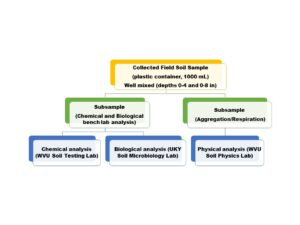
Statistical Analysis:
We used statistical analysis (ANOVA) on the data generated from high tunnel and grassland samples. We organized the data collected by management system, soil depth, farmer’s perceived productivity level (high or above average, medium or average, and low or below average).
Preliminary results are shedding light on the selection of the best laboratory tests for soil health assessment, and possible management recommendations. Results indicated a significant effect of management system on soil health indicators used in assessment. Figure 3 shows the differences in dry aggregation (Fig 3 a.) and bulk density (Fig 3b.) for grasslands and high tunnels at two soil depths. The results obtained for the indicators at different soil depths tells us the depth at which the farmer should take the soil sample for more accurate and useful results.
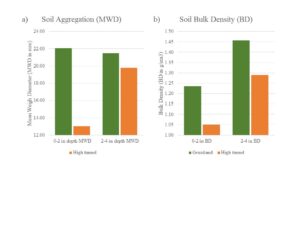
Although more samples will be processed to refine our results, the farmer’s described levels of soil health/productivity have successfully separated areas to be sampled. Figure 4 shows the differences in high tunnel soil organic matter for each farmer-defined level of soil health/productivity (low, medium, high). This approach (using farmer/indigenous knowledge) is being shown to be a good one to follow, but more research is needed to create recommendations based on this approach.
The sensitivity of the soil health indicator or soil health assessment property related to the farmers perception of soil health clearly remains of paramount importance for this proposed methodology to succeed.
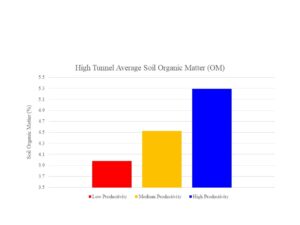
Figure 5 shows how the usually declining relationship between soil bulk density and organic matter changes with two different levels of soil health/productivity as perceived by the farmers. The observed differences in the two relationships were statistically verified by the regression coefficient for each: a better relationship (R2=0.83) between organic matter and bulk density where soil health/productivity was perceived to be high, than for the relationship was for samples taken where soil health/productivity was thought to be low (R2=0.66). The implication is that farmers can intuitively assist the selection and sampling of different areas for soil health assessment. This will lead to better analytical outcomes and improved recommendations.
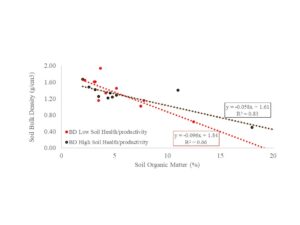
Farmer Input:
The 2021 meetings with non-participating farmers to get input on the experimental design was extremely helpful in the performance/conduct of the experiment in 2022. We will also use their input in the education/communication portion of the project.
For this project we developed a survey that was then conducted by trained students in 2022. The farmers answered the questions willingly and provided additional information that we needed.
The survey was created using updated information for existing national soil health laboratory analyses and will allow us to recognize the preferences of farmers using the proposed Appalachian Soil Health Analysis that will be performed at the WVU Soil Testing Lab. The activities required to create/complete the survey included zoom and face to face meetings between the PIs during Summer and Fall 2021 to discuss the survey. We also completed the student training to collect supplementary information to support the survey. An IRB request was submitted to WVU Sponsored Programs on 05/28/2021, and based on the characteristics of the survey provided to WVU, the survey was classified as Not Human Subject Research (NHSR).
The Research Compliance administration office concluded that:
The activity described does not meet the HHS or FDA federal definition of "research" that requires IRB review, amendments and/or approvals.
The activity meets the HHS or FDA definition of "research," but does not meet the corresponding regulatory definition of "human subject" requiring IRB review, amendments and/or approvals. (https://human.research.wvu.edu/get- started/determine-protocol- type/nhsr#NHSR%20Protocol%20Terms,%20Renewals%20&%20Amendments)
Our NHSR number is 2105323236, and was classified as not requiring review on 06/02/2021. The protocol is valid until 06/02/2026.
Year 2023:
No alterations were made to any aspect of the project, including the materials and methods (refer to the results section for additional information). As the project progresses, the results obtained and analyzed support the ongoing development of the project. The generated information proves to be highly beneficial for assessing Soil Health in both high tunnels and grasslands within the Appalachian region.
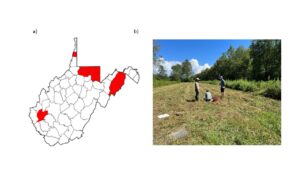
Research results and discussion:
The project has yielded results from farmer fields. We successfully visited and sampled 26 out of 30 farms. Figure 1-2023 illustrates examples of visited sites and the corresponding sampling process.
Our project's proposed hypothesis remains the driving force behind our research and education goals. Data processing is underway to rigorously test the hypothesis, with preliminary analysis completed on 150 samples collected from 26 farms.
Materials and Methods:
In 2023, we continued collaboration with last year's graduate students (two) and adhered to our original plan of training two new undergraduate students recruited in 2023. The new students underwent training in field sampling and laboratory processing and analysis of soil samples. The training occurred at WVU's certified Organic Farm, and laboratory methods training took place in the Soil Physics Laboratory at the WVU Agricultural Sciences Building. The soil sampling and laboratory analysis followed the diagram presented in Figure 2-2023.
The early retirement of one of our coPIs at the University of Kentucky, Dr. Mark Coyne, necessitated changes to the location of some biological analyses. To ensure project completion, the following adjustments were made:
PoxC analysis will be performed at WVU, with secured inputs and training for analysis completion.
Mineralizable N analysis will be conducted in the laboratory of Dr. Hanna Poffenbarger at the University of Kentucky.
Dehydrogenase analysis will take place at the Soil Health Laboratory at Cornell University. The logistics for these changes were finalized by the end of 2023, and the analyses are pending completion.
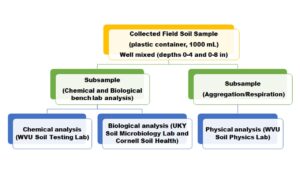
Statistical Analysis:
As the volume of data generated from high tunnel and grassland samples increased, we employed not only analysis of variance (ANOVA) but also regression analysis and nonparametric techniques to address qualitative data, such as soil health level/perception. The data were organized by management system, soil depth, and farmers' soil health perception categorized as high or above average, medium or average, and low or below average.
The results obtained from the new sample analyses conducted in 2023 contribute additional information to finalize the selection of the most effective laboratory tests for soil health assessment and potential management recommendations. The 2023 findings corroborated the 2022 results, highlighting a significant impact of the management system on the selected soil health indicators for assessment.
Figure 3-2023 demonstrates that bulk density in grasslands consistently surpasses that in high tunnels, irrespective of soil health level and depth. Furthermore, the data indicate that bulk density is consistently higher below the surface. While minor differences were observed, a soil characterized as healthier exhibited lower bulk density than an unhealthy soil. This result implies that a healthier soil will have higher porosity than an unhealthy soil, regardless of the management system.
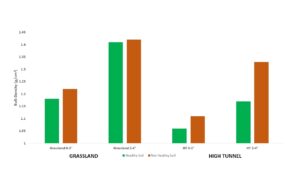
The findings for these indicators at various soil depths provide valuable insights into the optimal depth for farmers to obtain soil samples, ensuring more accurate and useful results.
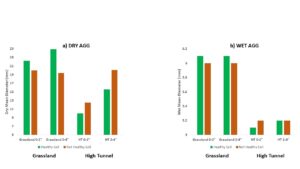
The 2023 results demonstrate the successful differentiation of areas with varying productivity levels based on the farmers' described levels of soil health/productivity. Figure 4-2023 illustrates the distinctions in high tunnel soil organic matter corresponding to each farmer-defined level of soil health/productivity (low, medium, high). This approach, utilizing farmer/indigenous knowledge, is proving to be effective and reliable.
In 2023, we initiated the development of recommendations derived from the assessment results and incorporated farmer input. The ongoing recognition of the soil health indicator's sensitivity and its correlation with the farmers' perception of soil health remains crucial for the success of this proposed methodology.
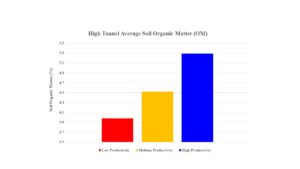
In high tunnel production systems, Figure 5-2023 illustrates that declining productivity, as perceived in unhealthy soils, corresponds to a decrease in soil organic content. This suggests that in high tunnels, organic matter serves as a reliable indicator of soil health.
However, if we were to recommend organic matter as a universal soil health indicator for samples not differentiated by production systems (grasslands vs. high tunnels), the relationship between soil health and organic matter content becomes less clear (Figure 6-2023). Although a higher organic matter content is observed in healthier soils, no statistically significant differences were recorded.
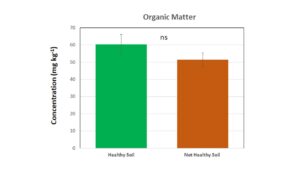
The variations observed between production systems, manifesting as changes in the relationships between soil health indicators like organic matter and bulk density, underscore the importance of considering differences in production systems when recommending soil health tests. The statistically verified disparities in the two relationships between production systems are reflected in the regression coefficients: a stronger relationship (R2=0.83) between organic matter and bulk density when soil health/productivity was perceived to be high, compared to samples where soil health/productivity was perceived to be low (R2=0.66).
This implies that farmers can intuitively contribute to the selection and sampling of different areas for soil health assessment. Such intuitive involvement can lead to more accurate analytical outcomes and improved recommendations.

High tunnels:
The adoption of high tunnels as a high-intensity agricultural production system in Appalachia is on the rise. Among all the soil health indicators, high tunnel farmers express a particular interest in information regarding soil electrical conductivity (EC) as a measure of developing salinity.
Surprisingly, the sampled high tunnels revealed no discernible relationship between EC and the described soil health level, contrary to farmers' expectations where lower EC was anticipated to be associated with lower soil health. To address this unexpected finding, we are measuring additional variables to provide farmers with a comprehensive explanation. Our suspicion is that fertility may be linked to EC, suggesting that lower fertility could be the underlying reason for this result. A test has been designed to explore this hypothesis. Figure 8-2023 illustrates the relationship between soil health perception and EC, revealing significant differences between EC levels.
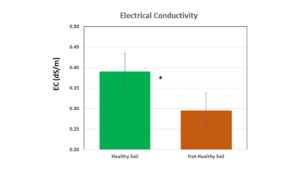
Another crucial soil health indicator for assessing soil health levels is soil pH. In the samples from high tunnels, pH did not exhibit a clear relationship with soil health levels. However, variations in pH within the 0-8 inches were indeed correlated with the soil health level described by the farmer. Figure 9-2023 a) demonstrates no difference when pH is measured as .an average value in the 0-8 inches, while b) reveals statistically significant differences when measuring the stratification or changes in pH within the 0-8 inches. We are currently working on determining how this sampling recommendation for assessing soil health will be communicated to the farmers.
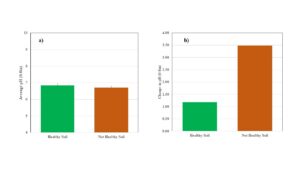
Willingness to Pay for the Affordable Soil Health Test for the Appalachian Region
There is a notable gap in the existing literature regarding the willingness to pay (WTP) for comprehensive soil health testing within the US agriculture setting. The success of establishing new soil testing services hinges, in part, upon the financial capacity of the farmers it aims to serve. Profitability emerges as a pivotal factor for farmers when considering the adoption of soil health-promoting practices (SHPPs), while the WTP for an agricultural service can be influenced by various socioeconomic and demographic variables.
Our preliminary data analysis stems from face-to-face surveys conducted by a team of five researchers. Farmers were provided with a Soil Health Score Card featuring 10 levels of soil health. They filled out the scorecard based on their perception, and a payment card was provided to select the maximum WTP. Figure 10-2023 illustrates a graph summarizing the WTP in relation to the Soil Health Score. Initial results indicate a tendency for WTP to increase as the soil health score decreases (correlation coefficient is -0.20), underscoring the significance for farmers to be aware of and manage lower soil health levels. Although preliminary, these data show promise in assessing the potential adoption of soil health tests in the Appalachian Region.
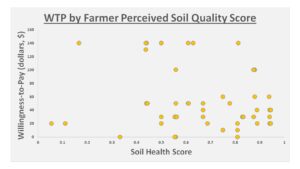
Farmer Input:
The meetings conducted with non-participating farmers in 2021 to gather input on the experimental design proved to be extremely beneficial for the execution of the experiment in 2022.
Unfortunately, we faced challenges in completing the expected education and communication components of the project due to several unexpected and extreme events.
Responses from the survey designed in 2022 and conducted in both 2022 and 2023 were analyzed by Dr. Ana Claudia Sant’Anna. She is currently in the process of completing her analysis with her student, who experienced health issues that hindered the completion of the analysis alongside Dr. Sant’Anna.
In 2023, we updated the Institutional Review Board (IRB) through WVU Sponsored Programs, even though the survey was classified as Not Human Subject Research (NHSR). Our NHSR number is 2105323236, and it was deemed not requiring review on 06/02/2021. The protocol remains valid until 06/02/2026.
2022 Research Conclusions
A preliminary set of 150 samples was analyzed to test the project hypothesis. The results indicated:
- Farmers were able to participate in our research firsthand, selecting three productivity levels in their production systems (grassland fields and/or high tunnels) and sites to be sampled. Using this collaboratively derived set of samples, we observed significant variability between production systems in the data sets, but it was possible to identify similar characteristics and trends that may aid in the selection of the best soil health assessment methods.
- Sampling protocols to be recommended to farmers and landowners have been tested for data quality. The farmers visited in 2022 also participated in the field sampling and found the sampling methods easy to perform.
- Communications with farmers and extension agents have been very smooth, and the surveys show interest in soil health tests and soil health testing. In some cases, the interest in the tests relies on information showing a relationship between soil health testing and recommendations to improve production/yield. With additional 2023 visits to farmer fields, soil sampling and analysis, we will be able to give additional information to the farmers and bring additional interest to the Appalachian Soil Health Test.
- Preliminary correlation analyses showed that selecting contrasting production systems gave us valuable information to be applied in the recommendation stage. Correlation analyses will also aid in selecting surrogate variables to analyze in the lab, resulting in faster and more cost-efficient lab work in support of soil health assessment.
- No recommendations (e.g. cover cropping, tillage reduction/cessation, organic matter addition, crop rotation components, and grassland management options.) have been developed. We need the complete set of proposed samples to complete that proposal objective.
Participation Summary
26 farmers participated in the research this year. We have 15 additional farmers identified, but it was not possible to visit and sample their farms in 2022.
Participation Summary
26 Farmers participated in the research.
Updated 2023 Research Conclusions:
A set of 150 samples was analyzed to test the project hypothesis, and the results revealed the following:
- The productivity levels described by farmers were evaluated through physical and selected biological soil health indicators, such as grassland diversity and biomass production. Collaboratively using this sample set, we observed significant differences between production systems in the 2022-2023 datasets. Despite these variations, we identified common characteristics and trends that can guide the selection of optimal soil health assessment methods.
- Sampling protocols recommended to farmers and landowners were tested for data quality, encompassing additional properties not assessed in 2022. Farmers who implemented the sampling methods found them easy to perform.
- Communication with farmers and extension agents has been seamless, and survey results indicate a keen interest in soil health tests and testing. We anticipate no challenges in organizing and delivering information to extension agents and farmers.
- Due to COVID cases, our team performed fewer visits to new farms than planned in 2023. Nevertheless, laboratory sample analyses were completed, enabling us to provide additional information to farmers and generate increased interest in the Appalachian Soil Health Test.
- Correlation analyses between soil health indicators and the soil health level described by farmers revealed that the values/magnitudes of soil health indicators differ between contrasting production systems. This novel finding provides valuable information applicable to the assessment and recommendation stage. Additionally, correlation analyses will aid in selecting surrogate variables for lab analysis, streamlining the process and enhancing cost efficiency in support of soil health assessment.
- We are uncovering relationships that have previously affected the ability of soil testing labs to develop recommendations, as summarized above. At this stage of the grant, recommendations such as cover cropping, tillage reduction/cessation, organic matter addition, crop rotation components, and grassland management options have not yet been formulated. Ongoing analysis of the results obtained from the proposed samples is essential to achieving this objective.
- Preliminary analysis of farmers' willingness to pay (WTP) for a "new" soil health test tailored for the Appalachian region indicates a correlation with the farmer's knowledge and perception of soil health. Farmers appear more inclined to invest higher amounts in soil testing when faced with lower levels of soil health.
Participation Summary:
27 farmers actively participated in the research this year, with an additional 15 farmers identified for future participation, although their farms could not be visited and sampled in 2023.
Education
Year 2022:
Research and education will be aligned with each other from the beginning of the work. When the proposal was written, we thought to focus on remotely delivered materials, given their advantage in allowing greater numbers of farmers to participate, and small field training groups. However, this approach may be modified since COVID conditions have changed. Presently, we participate in face-to-face meeting with farmers and county agents, but we will still be reaching more people using remotely delivered materials. Our education plan will follow the originally proposed three stages: 1) Soil health (SH) testing basics; 2) SH sampling and test result correlation; 3) SH result interpretation/recommended soil practices.
Since 2021, after a substantial delay in the project starting date due to an unexpected health problem affecting the team leader, substantial advances were made in 2022. We are in Stage 1 and simultaneously started Stage 2; supported by SARE’s grant and reputation, we have been having direct conversations with farmers and collaborators and are presenting our educational approach to smaller groups to get their support. We have received informal feedback, which we are using to improve our educational approach and materials.
For Stage 2, with the closest collaborators including the first group or "core farmer participants", we will be refining sampling procedures and making videos to be shared with future participants and clients.
We have collected, processed, and analyzed soil sample data, which is required to complete Stage 3. However, we need to perform scheduled year 2023 field sampling and analysis to complete this task.
Year 2023:
When the proposal was initially drafted, our focus was on remotely delivering materials due to the advantage of reaching a larger number of farmers and facilitating small field training groups. However, with the changing COVID conditions, farmers and extension agents expressed a preference for more face-to-face activities. We have actively participated in face-to-face meetings with farmers and county agents, delivering talks within and outside the state. Despite these in-person engagements, we recognize the continued effectiveness of reaching a broader audience through remotely delivered materials.
Our education plan adheres to the originally proposed three stages:
- Soil health (SH) testing basics;
- SH sampling and test result correlation;
- SH result interpretation/recommended soil practices.
Stage 1, focusing on Soil Health testing basics, is currently ongoing and has been very successful.
Following a significant delay in 2021 due to an unexpected emergency, major surgery underwent by the team leader, considerable progress was made in 2022. Stage 1 is 80% complete, and simultaneously, Stage 2, which is over 60% completed, has begun. With the support of SARE, we have conducted and continue to conduct presentations and engage in discussions with interested farmers and extension agents. Our educational approach is being presented to smaller groups to garner their support. The questions and suggestions received have been instrumental in refining our educational approach and materials.
For Stage 2, which has expanded to include groups beyond the closest collaborators, including the first group or "core farmer participants," we are refining sampling procedures and creating videos to be shared with future participants and clients.
We have processed and analyzed 70% of the soil sample data, a crucial step in completing Stage 3. However, the completion of this stage requires the scheduled field sampling and analysis for the year 2023.
Milestones
1- Farmer and extension agents will learn about the project and participate in development of a protocol for site and farmer selection
Start in June 2021.
5
1
5
2
July 15, 2021
Completed
March 15, 2022
Contacts with extension agents and farmers occurred between October 2021 and January 2022. Five (5) farmers/beneficiaries were selected and contacted with the help of extension agents and other researchers. Five (5) farmers confirmed participation and have been visited by the SARE grant team. We lost a project selected extension agent due to early retirement, but we were able to contact the Monongahela Conservation District to support our efforts. We did substitute this agent with another by the end of the year. The retired agent will continue collaborating with the project, due to the time already spent on the project.
Proposed New Completion Date: March 15th, 2022. The completion of the Milestone was achieved before the new proposed date.
2- Farmers (30) representing a range of high-tunnel growers and pasture farmers will be identified and “choose to participate” in project activities. Extension agents and the WVU Soil Testing Laboratory will collaborate to identify farmers by interest at the selected locations.
Start in June 2021.
30
1
26
3
July 30, 2021
Completed
March 30, 2022
In 2021 Milestone #2 was delayed due to unexpected health problems affecting the team leader. We pursued this commitment during the 2021 winter months and received answers and farmers’ commitments by the end of February 2022. By March 15th we had the group of participants selected from different counties in the Appalachian region of WV.
Proposed New Completion Date: March 30th, 2022. The completion of the Milestone was achieved before the new proposed date.
3- Farmers complete a survey about current soil health practices, perceived states of soil health in their fields/high tunnels, and limits/limitations to their use of soil health testing. They will meet with project staff to understand and determine commitment to project participation. They will provide feedback into soil health seminar development.
Start July, 2021.
30
1
26
2
November 30, 2021
Completed
September 15, 2022
In 2021 Milestone #3 was also delayed as explained for Milestones #1 and #2. The survey was developed in 2021, and pilot testing of the survey was competed in January/February 2022. Three students (graduate and undergraduate) were selected, and together with SARE coPIs were trained to conduct the survey.
Survey will be saved with other products.
This Milestone will be combined with Milestone #1 and #2. This Milestone is expected to start in April 2022 and completed by September 2022. The milestone was completed by the new proposed date.
4- Site visits to farmers’ properties. Farmers will participate in sampling design sampling strategy to submit samples to the WVU soil testing lab. Receive soil samples from participants reflecting categorical levels of soil health (expecting ca. 200-250 samples in the first group). Develop educational videos for sample collection with the participation of the farmers, extension agents, and researchers. Collect feedback to improve the interactions between PIs, extension agents, and farmers.
From Jul-Dec 2021, and Jun-Sep2022.
30
1
30
1
September 30, 2022
Completed
September 30, 2022
Although Milestone #4 had a late start (April 2022), we completed this milestone in the time initially proposed. Thanks to testing the sampling efficiency, and training the students to collect and initially process the samples (time needed to collect the samples following the specifically designed sampling method), and having already organized the logistics and activities to be performed at the farms, we were able to complete this Milestone despite an unexpected late start.
5- Farmers will participate in determine yield responses/indigenous or local production knowledge from sampled field/high tunnel sites. A second soil sampling event in the previously sampled areas will assess changes due to time and production system. Assess soil health status of participant samples using suites of available soil health indicators. Intensive laboratory analysis of the received soil health samples (expect ca. 200-250 samples in the second group)
From Jul-Dec2021, and Mar-Dec2022.
30
1
30
3
December 30, 2022
In Progress
Year 2022:
Milestone #5 was delayed in 2021, as explained in previous paragraphs, and the delay affected the starting time for the second sampling. The second sampling, to include time as a variable, was not completed in 2022 due to reasons out of our control. The sampling will be started in April 2023. We would propose a new completion date by the fall of 2023 (September 2023).
Year 2023:
We have not finished processing the 200 to 250 samples in 2023. Evaluations of our work in the third quarter of 2023 have revealed that we are currently between 8 months and 1 year behind schedule in completing our project milestones. While samples are still arriving at the lab at a slow pace, there has been insufficient time to complete the analysis. We have been actively inviting extension agents to participate in this sampling process, and we are in the process of organizing new meetings with our extension agents.
Proposed New Completion Date: September 30, 2024
6- Farmers will participate in a “remote” update/fall meeting to discuss the develop relationships/correlations between measured yield and indigenous/local production information and the measured laboratory soil health/test data. We will draft educational materials. Feedback will be requested on their degree of satisfaction with project progress and on the proposed education materials being developed. Recommend appropriate SH practices to participants based on least favorable SH indicator (i.e. the indicator in most need of improvement).
Start in November 2021.
30
1
30
2
March 31, 2023
In Progress
Year 2022:
Start time for Milestone #6 was delayed. The forced delay on previously described milestones was due to the required sequence of activities to be followed for the completion of this project.
Our first meeting with farmers was going to take place at the Boone County (WV) Field Day in the second week of September 2022. The target was 50-70 producers. The venue was at Mr. Johnny Ball’s farm, but he suddenly passed on the first week of September 2022. We do not yet have a new date for this activity.
We have scheduled another meeting in Charleston on April 1st, 2023, to speak to 80 participants about our SARE project and preliminary results. The meeting is with farmers and gardeners.
Year 2023:
In addition to our Charleston meeting in April 2023, we conducted a presentation meeting with the Agriculture and Natural Resources Extension Agents at the 2023 ANR Fall Unit Meeting (Jackson’s Mill assembly Hall, Nov 28-29). We have drafted educational materials initially as handouts for our presentations directed:
- a) to farmers and landowners, and
- b) to update extension agents on the proposed analyses and request feedback.
Feedback was sought from participants following our April meeting regarding the quality and clarity of the presented data. WVU Extension delivered the summary results, which were highly encouraging, motivating us to continue conveying our message to potential users (See table below). We will use the feedback to improve our message presentation to future clients.
Proposed New Completion Date: October 30, 2024
Extracted from the document titled: “April 2023 WV Master Gardener Association’s Annual Conference and Speaker Evaluations” (https://drive.google.com/drive/folders/1M3-0fpn4hbHMFwK3o7kf8fkLfvu95OLl?usp=sharing - uploaded July 5, 2023). Note: 1 = very poor; 2 = poor; 3= average; 4 = good; 5 = very good.
Table:
|
Eugenia Pena-Yewtukhiw |
5 |
4 |
3 |
2 |
1 |
N/A |
Totals |
Average |
|
1. Teaching Strategies |
17 |
5 |
1 |
23 |
4.7 |
|||
|
74% |
22% |
4% |
0% |
0% |
0% |
|
||
|
2. Effectively Communicated |
16 |
3 |
3 |
22 |
4.6 |
|||
|
73% |
14% |
14% |
0% |
0% |
0% |
|
||
|
3. Relevant, up-to-date info |
18 |
2 |
3 |
23 |
4.7 |
|||
|
78% |
9% |
13% |
0% |
0% |
0% |
|
||
|
4. Info as written in description |
20 |
2 |
22 |
4.9 |
||||
|
91% |
9% |
0% |
0% |
0% |
0% |
|
||
|
5. Well prepared to teach |
19 |
2 |
1 |
22 |
4.8 |
|||
|
86% |
9% |
5% |
0% |
0% |
0% |
|
||
|
6. Info presented able to understand |
14 |
4 |
3 |
1 |
22 |
4.4 |
||
|
64% |
18% |
14% |
5% |
0% |
0% |
|
||
|
|
|
|
|
|
|
|
|
|
|
S = strongly agree; A = agree; D = disagree; SD = strongly disagree |
||||||||
|
S |
A |
D |
SD |
|
||||
|
7. Developed new skills |
9 |
13 |
22 |
|
||||
|
41% |
59% |
0% |
0% |
|
||||
|
8. Able to use info |
11 |
11 |
22 |
|
||||
|
50% |
50% |
0% |
0% |
|
||||
|
9. Worthwhile session |
15 |
8 |
23 |
|
||||
|
65% |
35% |
0% |
0% |
|
||||
Comments
Very good speaker, easily explains her subject
Good job managing opposing opinions by attendees
Good speaker, encourages class participation
Excellent
Excellent speaker
Needs tables in rooms for people with disabilities, not just chairs
7- Optimize diagnostic tests for soil health and determine the most cost-effective measures to use in assessing soil health status and change in soil health status. Describe second phase of the project.
Start in Mar 2022.
30
1
30
3
August 31, 2022
In Progress
Year 2022:
We started this Milestone, #7, in August 2022, but we expect to complete this milestone in the time initially proposed. The optimization requires all the samples to be analyzed, and we have a delay in laboratory results returning on time.
Year 2023:
We have advanced concurrently with other milestones, specifically Milestone #7. The analysis of soil health status, based on the feedback from the initial 30 farmers, is currently undergoing comprehensive scrutiny and extrapolation to new situations.
Proposed New Completion Date: December 15, 2024
8- Farmers will give input on the economic analysis. Discuss advantages and disadvantages of the possible tests in a meeting with the project participants. Provide open ended questions to the participants. Start in May 2022.
30
1
30
3
October 31, 2022
In Progress
Year 2022:
Milestone #8 has not been achieved. We are expecting some additional soil sample analyses to be completed in the first trimester of 2023. This will provide the discussion and economic analysis data required to complete the milestone.
Year 2023:
The economic analysis, led by Dr. Sant’Anna, is progressing well. We expect to receive results earlier this year once the final biologic laboratory analyses reach our offices. The economic findings will be distributed to collaborating farmers via both mail and email. To address potential delays in responses from some farmers, we intend to personally visit and call collaborators.
Proposed New Completion Date: October 30, 2024
9- Farmers will be participating in a Survey about choice of soil health practices, value of testing, and perceived returns on investment. Produce a report and analysis of survey responses.
Start in Oct 2022.
50
1
30
3
December 30, 2022
In Progress
Year 2022:
Milestone #9 was started in 2022, and is still in progress.
Year 2023:
Milestone #9 hinges on the completion of Milestone #8. We have initiated the development of the new survey, which will be submitted to the new farmers and farmer collaborators based on the preliminary economic analysis performed by Dr. Sant’Anna. The survey will be distributed to collaborating farmers through both mail and email. To account for potential delays in farmer responses, we plan to personally visit and call collaborators.
Proposed New Completion Date: November 30, 2024
10- New farmers will be recruited as new adopters. Use the videos and other educational materials developed by the project in the recruiting process. Survey the new group of adopters.
Start in February 2023.
100
1
30
3
September 29, 2023
In Progress
Year 2022:
Milestone #10 has been started by assisting to meetings and engaging new farmers into the project as new information is being shared in the meetings.
Year 2023:
In 2023, we contacted 50 new farmers, but as of now, the participation of only 8 has been confirmed. While the additional contacted farmers have expressed interest, we are currently awaiting their confirmation.
Proposed New Completion Date: December 2024 – January 2025
11- Farmers will continue to participate in the development of improved diagnostic tests and more appropriate educational materials. Seek for continuing funding and collaborators.
Start in May 2023.
100
1
30
3
February 29, 2024
In Progress
Year 2022:
Milestone #11 has been started by going to meetings and engaging new farmers in the project as new information is being shared at these meetings.
Year 2023:
In 2023, the meeting with the extension agents in Agriculture and Natural Resources Extension Agents at the 2023 ANR Fall Unit Meeting (Jackson’s Mill assembly Hall, Nov 28-29), we secured additional 15 clients through extension agents that volunteered to collaborate with us in additional counties.
Proposed New Completion Date: December 2024 – January 2025
Milestone Activities and Participation Summary
Educational activities:
The methodology to process samples was taught to students involved in this project. This training was performed on multiple occasions and took over 20 hrs.
Participation Summary:
Learning Outcomes
Year 2022:
We have not collected enough verifiable information to complete this task. Our project has not reached the phase to provide the data requested (exit survey).
Year 2023:
Farmers mentioned that the method of collecting soil samples provided them with an understanding of how specialized sampling for soil health, particularly for aggregation, could be conducted. They also learned that soil sampling for chemical or biological properties could be done in a similar manner, with the collected samples being split for respective analyses.
However, farmers expressed concerns about the interpretation of biological properties. They anticipate challenges in generating recommendations related to biological aspects of soil health.
Performance Target Outcomes
Target #1
200
By the end of the project the farmers will adopt laboratory soil health measures as a basis for implementation of sustainable conservation management practices.
25/year high tunnels and 1000 acres of grassland per year
A 20% improvement in at least one soil health indicator for those that adopt the New WV Appalachian Soil Health and implement recommended sustainable conservation/management practices.
Year 2022:
Our project has not advanced to the stage of providing the requested data. The necessary information for verification has not been collected.
Year 2023:
Data on the adoption and willingness to adopt the new soil test was collected. Nonetheless, challenges such as incomplete data sets and disrupted visits impeded our ability to complete this necessary information promptly.
Year 2022:
Our project has not reached the phase to provide the data requested.
Year 2023:
Preliminary willingness of adapting a "new Appalachian region" soil health, is significant. Unexpected results have shifted slightly one of our surveys (more in the result section).
Year 2022:
Our project has not reached the phase to provide the data requested.
Year 2023:
Our current data is anecdotal. We are in the process of designing an instrument that incorporates verifiable information while respecting the privacy requests made by some farmers.
In 2022, our project has not reached the phase to provide the data requested.
In 2023, we can report that over twenty (20) farmers verbally reported implementing some measures, but we have not verified this information through visits. The data has not been separated by farms; however, it is noteworthy that the High Tunnel producers, experiencing evident issues with chemical soil health indicators, were the ones who took action. While physical health indicators assisted in understanding certain issues, no specific improvement measures were designed. To gain specific data from closely followed farmer collaborators and gather "perception data" from other groups, further visits are needed.
For grassland farmers, their focus shifted to managing fast-responding health indicators, particularly fertility. We believe these changes were primarily influenced by the biomass production reports we shared with them. To gain a comprehensive understanding, we need to complete this analysis with visits to the farmers, ensuring accurate and detailed information for a thorough assessment.
Adoption of the new soil health test is a key objective for us, aiming to provide verifiable information demonstrating the positive impact of our projects on farmers' lives. Unfortunately, our project has not advanced sufficiently in data analysis to yield the requested verifiable results. While some necessary information for verification has been partially collected, scheduled visits to the sampled county and collaborators for further data gathering were hindered by COVID infections in our team at crucial project dates (visit dates). Regrettably, the rescheduled trips were also not completed.
Despite the project starting with a significant delay due to unexpected/emergency health issues of the team leader, efforts were made to plan and strategize to “catch up" without compromising quality. The WVU Soil Physics and Soil Testing lab completed over 600 soil tests, analyzing 80% of the data, providing valuable insights into soil health. However, unforeseen retirements and health issues among collaborators necessitated adjustments, with new collaborators joining the project to fill critical roles. Adjustments had to be made to reschedule and undertake the soil analysis responsibilities initially assigned to Dr. Coyne (University of Kentucky collaborator), who unexpectedly retired at the end of 2022. The sudden health problems and retirement of Dr. Shockey in mid to late 2023 impacted activities discussed between the team and Extension agents. We have invited Mr. Brian Wickline and Emily Morrow (Monroe Co. and Jefferson Co., WV Extension Agents, respectively) to join our project as new collaborators. We are in discussions with them regarding the data we have collected, and they have accepted to support our efforts. Both have already played a role in recruiting their clients to participate in the project.
WVU institutional transformation processes have adversely affected our project, disrupting the seamless communication between WVU Extension agents and WVU faculty. This situation was sensitive and had repercussions on the well-being of faculty for several months, significantly impacting the work efficiency of the WVU team and collaborators. The creation of a new WVU Division that includes the Davis College and WVU Extension implied a reorganization of the units involved in our project. We are in contact with our extension collaborators, and we will be able to make up for lost time.
Given these circumstances, we must formally request a no-cost extension. The extension for 2024 will enable us to conduct the final round of in-person visits to collaborating farmers, complete outsourced soil analyses, conclude data analyses and verification, and finalize meetings and educational activities. The in-person visits are crucial for acquiring essential information, addressing challenges faced during the project, and achieving our overarching goals. Your approval of the extension would significantly contribute to ensuring meaningful and verifiable results for the success of the project.
Additional Project Outcomes
Year 2022:
We have not collected enough verifiable information to complete this task.
Year 2023:
The project was drafted and submitted to the Organic Center (FFAR). The preproposal was presented in May and received acceptance. Following this, the full proposal was composed and submitted in July 2023. The reviews were favorable and encouraged us to submit to NIFA grants due to the committed funding from the FFAR agency. The proposal was titled:
DOES CHANGING ORGANIC SHEEP MANAGEMENT SYSTEM INCREASE PROFITABILITY, GRASSLAND PRODUCTIVITY AND SOIL HEALTH?
The project abstract was:
Research on soil health and management systems often overlooks the broader impact on the entire farming system and its relation to profitability. Little is known about the effects of different grazing management systems (rotational or continuous) on soil health and its productivity value in organic sheep farming and revenues. This proposal objective is to assess the above and below-ground ecosystem health, climate change resilience and farm profitability of organic continuous and rotational sheep grazing system, by analyzing the relationship between soil health, organic sheep productivity and profitability.
We propose to design and establish in consultation with sheep producing farmers a field experiments in an organic certified farm in which a rotational and continued grazed paddocks. Soil health indicators (soil organic matter, dry and wet aggregation, hydraulic conductivity, available water, soil respiration, nitrogen enzymes, PoxC, biomass and plant diversity) will be monitored, and related to animal performance and productivity. The systems economic inputs (e.g. inputs/output costs) and outputs (e.g. product value) will be monitored and dollarized, to create an economic soil health indicator for organic sheep grazing systems. Analysis of variance and multiple regression will be used to group variables to determine their weighed influence on soil health value.
Our results will include quantifying the value of soil health in different organic grazing systems to soil health (soil-grassland -animal productivity). With the input of farmers we expect to establishing/creating a social media and online discussion platform that relates soil health to profitability for organic sheep grazing producers.
The proposed research/outreach /extension project proposed will provide a method to quantify soil health in organic systems in addition to design outreach methods to train farmers in evaluating economics of soil health.
Years 2022 & 2023:
We have not collected verifiable information to complete this task.
Years 2022:
We have not collected enough verifiable information to complete this task.
Years 2023:
While the project has made substantial progress, it has encountered challenges that impeded the completion of all planned activities leading to the final product. A key aspect contributing to the project's success lies in the robust research methodologies employed, emphasizing thorough data collection and analysis. The structured educational methods also played a pivotal role in engaging stakeholders and disseminating project insights.
Challenges primarily arose from unforeseen personnel issues and external factors, impacting the timely execution of certain activities. To address this, we would benefit from a extension in our initially accepted timeline. Additionally, enhancing communication channels among project team members and stakeholders could streamline coordination and alleviate potential setbacks.